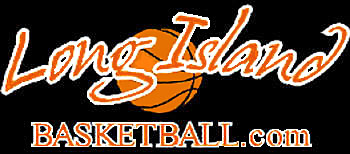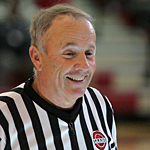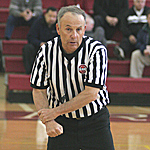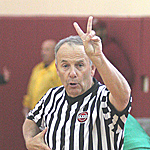 | ||||
MARATHON!
QUESTION - I value your knowledge of the game, so I have a rules question for you. A1 is driving to the basket for an easy lay-up. B1 pushes A1 from behind. A1 scores the basket. The trail referee calls an intentional personal foul. My question is how many foul shots do you shoot? The NFHS book says two shots and ball out of bounds for an intentional foul. I have asked several referees and one rules interpreter. Some referees say one, some say two and the rules interpreter said three. His reasoning (which I think was wrong) was that an intentional foul is a technical foul, so you shoot one for the basic foul and two for the technical. I disagree with that ruling since an intentional foul can be either a personal or technical. In this case it was a personal foul. So what's the solution?
ANSWER - I have trouble believing you found an interpreter with that answer......it certainly wouldn't have come from any of the interpreters here on Long Island. Our guys are ALL outstanding in their knowledge of the rules. In this situation, the intentional foul is "two shots and the ball out of bounds at the spot nearest the foul." That's it.
QUESTION - Skip, here's one for you. Player A-1 is fouled and the scorer informs the official it is the 10th foul on team B. The first shot is unsuccessful and the second one is good. When Team B has the ball for the throw in, the scorer informs ref that it was actually only the 9th foul. The ref cancels the last free throw and resumes play with the alternating possession procedure. Was he right?
ANSWER - When I first read this question, I also wanted to go with the alternating possession procedure. But after reviewing the rule, I found that's the wrong decision. Here's why. By rule (2-10 art. 6) after the correction, play will resume from the "point of interruption" (which is the time at which the error was brought to the attention of the officials). So, the officials will first make the correction by canceling the "unmerited free throw" and then will resume play from the point of interruption, which happened when Team B was taking the ball out. So, no alternate possession. It will be Team B's ball for the throw in. (Note to Rule Book people.....Case Book play # 2.10.1-D does not agree with Rule 2-10 art. 6)
QUESTION - Let's say a player was going to shoot a three pointer and while he is in the air loses control of the ball without it ever being tipped by anyone. The ball then goes about 10 feet away and the player then goes and catches it. Is this a travel?
ANSWER - Good one! The basic answer is NO, it is not a travel. But let's look at it more closely to see why. Any time a player is in the air, we like to say he's only "permitted" to do two things.....shoot or pass. What we don't say is that he could also call time out and it's possible he could "fumble" the ball. IF the official judged that the shooter was "in the act of shooting" then (like any other missed "try for goal") the shooter can run down his missed shot and it's all perfectly legal, plus he can dribble again! (Have fun trying to explain that one!) Or, if the official didn't see this as being in the act of shooting, the only remaining option is to see it as a "fumble," which by rule is the "accidental loss of player control." Since a player is permitted to fumble the ball and to recover it, it is NOT a travel. I know it doesn't seem right, but I checked with higher authorities on this one. That IS the rule. One more thought.....if the referee saw the player really did NOT lose control and then threw the ball to the floor and was first to touch it after it hit the floor, THAT would be traveling.
QUESTION - Skip, first I would like to say I enjoy these reads and your answers to some strange events. Here is one for you. Team A commits a foul and team B is in the bonus and they go to the line to shoot a 1 and 1. The officials erroneously allow team B to line up in the lane spaces closest to the basket. No one notices it, not even the other team who might usually call attention to it. The free throw shooter makes both shots, so we can say there was no advantage to the lane placements. However because they were closest to the basket, Team B now takes the ball out of the net and steps out of bounds and throws it in. The clock starts and just as the team B player takes a dribble, the ref blows his whistle and rightfully awards the ball to team A on the baseline. All is well now and no harm was done. My question is what would happen if the team B player missed the foul shot and his teammate having inside position gets the rebound and scores? Is there any recourse to correct this? In looking at the 5 correctable errors I’m not sure if this really falls under them.
ANSWER - No recourse. It is not correctable and the basket stands.
QUESTIONS - Skip, you said there was to be a point of emphasis on "displacement" and used the post play as an example. I have several questions:
Q1. On a box out, does that rule still apply? I am not talking about hip bumps, but after inside position is established, is the defender allowed to move the boxed out player back?
ANSWER - YES, the rule applies....so, NO, the defender may not dislodge his opponent and move him out. The player who is boxing out may "seal" his opponent, but not dislodge him.
Q2. Is the boxed out player allowed to push the defender under (I am not talking about marginal movement)?
ANSWER - Same as above....the boxed out player may go around the defender but cannot dislodge him.
Q3. When the defending post player is 3/4 in front, is the defender allowed to knock in the post player with either arm?
ANSWER - More of the same.....each player is entitled to his legal position and neither is allowed to dislodge his opponent.
Q4. Is clapping in the opponent's face taunting?
ANSWER - It depends on how it's perceived by the official. If the clapping is right in the opponents face AND the official judges it to be taunting, then a technical foul is in order. If it's borderline, the official may choose to give a verbal warning.
Q5. Is chest bumping (to remove a player from his position) legal?
ANSWER - As above, contact that causes an opponent to be dislodged from a legal position is not legal.
Q6. Have the rules been changed on handchecking with two hands (on or off the ball)?
ANSWER - NO, the rules are the same. However, it's not quite that black and white........the official must judge who is causing what to whom AND determine if either player is gaining an advantage. For example, if the offensive player is driving his body into the defender, it's tough to penalize the defender even if his two hands happen to be in contact with his opponent. In that case, it could well be a foul on the offensive player.
QUESTION - What are the guidelines for the 5 second count on an inbounds play when the offense just rolls the ball up the court, often to near the half court line? I have never seen the “5 seconds” called on that but those plays often seem to be a violation.
ANSWER - As soon as the ball is available to the thrower-in, he then has 5 seconds to pass, or roll, the ball onto the court. That 5 second count continues only to the point when the ball is released.
QUESTION - Is it a back court violation if offensive player A-1, in his front court, attempts to throw pass to teammate A-2 and defensive player B-2 deflects the ball and it accidentally bounces off A-2's elbow and then goes into the back court? Is this a back court violation or can A-2 go back and get the ball?
ANSWER - It will be a back court violation if A-2 (or any of his teammates) is the first to touch the ball in the back court. As the play was described, the ball was "last touched" by team A in the front court before going into the back court, so team A is "deemed to have caused the ball to go into the back court." This is really no different than if the ball had gone out of bounds. The ball is ruled to be "off of team A..." Further, once that ball goes into the back court, team A had better hurry up and get to it first (even though it will cause a violoation) because the ball is loose and either team can grab it.
QUESTION - I accidentally called a timeout during a high school game in Illinois, while the opposing team was in possession of the ball. The referee blew the whistle to stop play, then realized that we were not in possession of the ball and assessed me a technical foul. He told me that if he had not stopped play and had just told me we were not in possession, it would have been OK. Never saw that one in 22 years. Opinion?
ANSWER - This is a troublesome play. By RULE once the time out has been called and play has been whistled dead (even if in error....) it must be granted and charged (5.8.3E - casebook). The official must "eat the error." There is no provision for a technical foul on that play, assuming the play occurred as you stated it.
But you're talking to a referee here....and I'm hesitant on the part of the referee because maybe there was just a little more to the play than what you described?? For example, could it also have been that your opponent was in transition on a fast break when you "accidentally" called the time out??? I could see how, in the heat of an exciting contest, both you and the official might lose focus and be calling a time out. Now what? The opposing coach might then implore the officials (and everyone else in the gym) to believe that this time out just cost his team a layup. Whether or not that is true, the officials would have to confer and try to determine if this error put the opponent at a disadvantage. If they believe that happened, they would have every reason to call a technical on you for unsportsmanlike conduct (Rule 10.4.1 and 2.3).
QUESTION - In HS basketball in Indiana when can a player enter the free throw lane? Some say it's when the shot is released and others say it's when the ball hits the rim. Which it is? Thanks.
ANSWER - I don't know that the high school rules in Indiana are any different than here in New York (there may be some minor differences). So, generally speaking, in high school you must wait until the ball hits the rim before entering. In college (NCAA rules) you may enter after the release of the shot. Next chance you get, ask a local high school official and he should be able to set the record straight in Indiana.
QUESTION - Hello. I was searching the Internet for a referee rule book but ended up finding this web site. I actually have several questions:
1. When a player hustles for a loose ball and gets it on the floor and another player jumps on his back, is it a jump ball or foul?
ANSWER - Simple. FOUL!
2. What can I do if there are refs that are purposely not making fair calls? This is an observance of 6 games where the crowd was booing the refs (certainly not sportsmanlike). The one ref gave a player a tech for having his hand on another player's jersey (no warning). Is that right?
ANSWER: No, not as you described it. Unless there was some type of unsportsmanlike conduct going on, it's more likely that a personal foul would be called, not a technical. Are you sure you saw the entire play and there wasn't more to it than "having his hand on...."? And, as far as what you can do.....?? Nothing, really. But I suppose you could continue to read this web site!
3. A player who is a 5' 10" point guard goes up for lay up and when he comes DOWN he lands on a 6' 3" player who ran underneath him and ref called a foul on the point guard. How can the player stay in the air? Is that the proper call?
ANSWER: Well, certainly the player (shooter) cannot "stay in the air" but maybe he should have pulled up instead of going airborne in the first place. Since you are not trained to observe the movements of the players in the way that certified referees are, my hunch is that official saw the defensive player "move to obtain a legal guarding position" momentarily before the point guard left the floor for his shot. If that is the case, when the shooter came down ON his defensive opponent, it should be obvious that the shooter had now placed his defensive opponent at a "disadvantage" which necessitated the referee calling a foul (player control, in this case). If the shooter had come down to the ground and then bumped the defender, the referee might have "passed on the call" and let it go. But it doesn't sound like that's what happened here.
Do you have a question? Have you seen a play you didn't understand? Was there a controversy you'd like clarified? Send your questions in and I'll do my best to get you an answer.
Skip Yutzler
IAABO Board 127
39 Years High School and Junior College Official
5 Times NY State HS Championships - Glens Falls

# 65
Ask The Ref !

Your Basketball Home
Although information on this site is believed to be correct, the information is provided on an "as is" basis and its accuracy and/or completeness cannot be guaranteed. No warranty of an kind is given with respect to the contents of this website.
All stories, photos and graphics are copyrighted material and may not be used without specific written permission
This Website designed and maintained by
Member, The Online News Association
Member, The New York State Sportswriters Association



